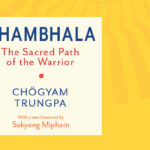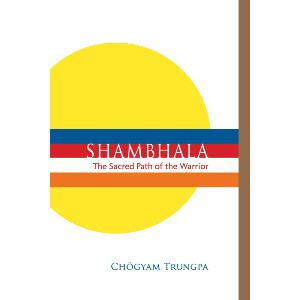Kate, our Production Coordinator/Designer, sums up our August meeting of the new Shambhala Publications Book Club! August’s book selection was Shambhala: The Sacred Path of the Warrior by Chögyam Trungpa Rinpoche. We invite you to take part by sharing your comments below.
There are a lot of different kinds of people who work at Shambhala Publications. We come from a wide array of backgrounds, and each of us has a unique story about how we found our way into our various niches of publishing. But one thing I think I can safely say we all have in common is a deep love of reading. I can think of no better way to celebrate both our passion for the written word and the beautiful diversity of our perspectives than to come together for a Shambhala employee book club.
Every month, we will be gathering to discuss a book of our choosing from the immense library of titles that Shambhala Publications has made available to the world in the past five decades. Our first discussion, on Chögyam Trungpa Rinpoche’s classic, Shambhala: The Sacred Path of the Warrior, was so interesting and uplifting that it felt selfish to keep such an enriching experience to ourselves. So in that spirit, we’ve decided to share some of the fruits of our discussions every month with you, our fellow readers, so that we may all benefit from hearing the perspectives of others and expanding our worldviews. So without further ado, it is my honor to present a summary of our very first Shambhala book club discussion on Shambhala: Sacred Path of the Warrior.
One of the lenses through which we began to parse the text was the relative secularity vs religiosity of the book, and it’s a topic we returned to again and again throughout our conversation. In her preface, editor Carolyn Gimian presents the teachings Trungpa offers through this book as an “unmistakably secular rather than religious outlook” (xvii). So we raised the question: do we agree? Our group was composed of people with experiences from several different faith traditions and other belief systems, so it was interesting to hear how the book came across to each individual. Those of us with knowledge of Buddhism were able to recognize many familiar elements in the teachings, like the presentation of sitting meditation, mindfulness, and basic goodness. Trungpa does, however, make an explicit effort to present a nonsectarian path and draws on references from many different cultures and time periods to demonstrate that the wisdom of these teachings has existed in many forms throughout history and therefore can be accessed by anyone with a genuine desire to do so. But the bulk of the text is focused on experiencing life and the world around you as it really is, which doesn’t necessarily have to be associated with religion at all.
After returning to the topic multiple times, with many arguments for and against the text’s secularism, our marketing coordinator Emma broke it down in a way that I found incredibly helpful. She pointed out that the terms secular and religious can each mean very different things to different people; what strikes me as overtly religious might strike you as wholly secular. Ultimately, the question of whether the Shambhala teachings are secular or religious doesn’t bother her because the teachings help her so much. I’d characterize that as an excellent mic drop moment, reminding us all that the labels we use to understand the world around us are never as useful or meaningful as we tend to believe them to be. The real value lies in the substance of the thing, which can rarely be reduced to a simple, clearly defined category.
Another topic we spent some time exploring was time. Roost editor Juree called our attention to the following passage: “The way to experience nowness is to realize that this very moment, this very point in your life, is always the occasion. So the consideration of where you are and what you are, on the spot, is very important. You should regard your home as sacred, as a golden opportunity to experience nowness. Appreciating sacredness begins very simply by taking an interest in all the details of your life. Interest is simply applying awareness to what goes on in your everyday life—awareness while you’re cooking, awareness while you’re driving, awareness while you’re changing diapers, even awareness while you’re arguing. Such awareness can help to free you from speed, chaos, neurosis, and resentment of all kinds. It can free you from the obstacles to nowness so that you can cheer up on the spot, all the time” (65). This passage really gets to the heart of the Roost Books imprint. The vision of Roost is to publish lifestyle books that will encourage people to appreciate the beauty, magic, and sacredness of the everyday, domestic world around them, to achieve and share the kind of positivity that Trungpa Rinpoche is discussing in this passage. Marketing manager for our online courses department Markus commented that while he was reading this passage, he was struck by the fact that this book was published a full fifteen years before The Power of Now by Eckhart Tolle, leading to the beautiful one-liner from sales and marketing director KJ, “Nowness is trending” (and has been for some time now). Chögyam Trungpa was certainly ahead of his time.
But perhaps a better way to put it is that this book is timeless. The way Trungpa Rinpoche describes the world in 1984 in a way that is remarkably similar to the world we’re living in in 2017. He writes, “The current state of world affairs is a source of concern to all of us: the threat of nuclear war, widespread poverty and economic instability, social and political chaos, and psychological upheavals of many kinds. The world is in absolute turmoil” (7). This can certainly be viewed in a negative light as a terrifying and distressing indicator of how little progress we’ve made in the world over the past three decades or so. But perhaps it can also be hopeful in a sense, as Trungpa Rinpoche believes he is presenting the antidote: if each of us does the work to embody the warrior he describes, we will be able to overcome these exact issues. Either way you choose to view it, it’s clear that this book is as valuable now as it was at the time of its publication.
But how do we stay attuned to Chögyam Trungpa’s sage advice to start with yourself and your immediate surroundings when things are playing out on the national and international stage with such a sense of urgency and crisis? And how can we reconcile a fundamental belief in the basic goodness of humanity with the evil and cruelty we’re witnessing on a regular basis in today’s world? Online course manager Jade encounters this question as a sort of koan in her own practice. She is constantly training to see the basic goodness that already exists in the world at every moment. But when she loses that, there’s a lot more room for aggression to come in. In her words, “It feels like through my own path and reconciling with my own aggression and the ways that I lose contact with my reality, it makes it a lot easier to relate to people who are so blinded by aggression and delusion that they’re perpetuating these hateful acts.” Social activism may be inspired by anger, but it can’t be fueled by it; we need to balance our activist spirits with the inner work of the warrior so that we don’t just perpetuate the same aggression we’re fighting against in a different form. And the painful emotions we experience when we witness injustice in the world is an essential part of warriorship. According to Chögyam Trungpa, “This experience of sad and tender heart is what gives birth to fearlessness. . . . Real fearlessness is the product of tenderness. It comes from letting the world tickle your heart, your raw and beautiful heart. You are willing to open up, without resistance or shyness, and face the world. You are willing to share your heart with others” (22). And perhaps by doing so, we may be able to affect profound change.
We cannot stop there, of course, brokenhearted and watching the world crumbling around us. Chögyam Trungpa encourages us to “try to think beyond our homes, beyond the fire burning in the fireplace, beyond sending our children to school or getting to work in the morning. We must try to think how we can help this world. If we don’t help, nobody will. It is our turn to help the world” (8). But at the same time, “while everyone has a responsibility to save the world, we can create additional chaos if we try to impose our ideas or our help upon others” (8). So how do we find the middle ground? “The premise of Shambhala vision is that in order to establish an enlightened society for others, we need to discover what inherently we have to offer the world. So, to begin with, we should make an effort to examine our own experience, in order to see what it contains that is of value in helping ourselves and others to uplift their existence” (8). Before you can effectively help anyone, you have to cultivate the patience and discernment to see what your contribution should be, what your piece in the big puzzle is, how you can make a difference in a way that is natural and suitable to you, rather than imposing grand ideas and wreaking additional havoc in the world. Trungpa Rinpoche doesn’t offer specifics, because what each person has to offer is necessarily unique to the individual. By stripping away any prescriptive plans of action, Trungpa Rinpoche’s advice for creating an enlightened society is able to transcend boundaries of culture, time, and place, and could be useful for anyone, anywhere, in any context.
Lest you get the impression that our whole discussion was entirely comprised of very serious big ideas, you should know that we were all delighted by office manager Lindsay’s suggestion that Chögyam Trungpa would get along splendidly with Marie Kondo. The organizing consultant and New York Times bestseller is famous for her unique approach that continually challenges us to “spark joy” (or, in Chögyam Trungpa’s terms, “raise windhorse”) through a heightened awareness of, and relationship to, our surroundings. Let’s be real: her book might as well be called The Life-Changing Drala of Tidying Up. I would love nothing more than to hear Chögyam Trungpa’s thoughts on the drala of a well-organized sock drawer.
I’ve only summarized a few of the topics we explored, and there’s so much more to this book than we were able to cover in one hour; we’ve barely scratched the surface. The conversation does not end here. We’d love to hear from you about your experience reading this book, so feel free to leave comments below or on social media. You can find us on Facebook as Shambhala_Publications or on Instagram @shambhala_publications and use the hashtag #shambhalabookclub so we can find your posts.
We know that the experience of sharing our thoughts and questions with others helps us broaden our perspectives and illuminate aspects of the book that we might otherwise have overlooked, and we know that the more people who get involved, the more uplifting, energizing, and inspiring the conversation can be.
What did you think? And what would you like our next Book Club pick to be?
Shambhala: The Sacred Path of the Warrior
$19.95 - Paperback


